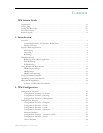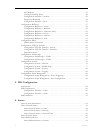
VBrick WM Appliance Admin Guide 1
Chapter 1
Introduction
Topics in this chapter
Overview . . . . . . . . . . . . . . . . . . . . . . . . . . . . . . . . . . . . . . . . . . . . . . . . . . . . . . . . . . . . . . . . .1
Typical VBrick Applications . . . . . . . . . . . . . . . . . . . . . . . . . . . . . . . . . . . . . . . . . . . . . . . . . .2
VBrick Reflecting. . . . . . . . . . . . . . . . . . . . . . . . . . . . . . . . . . . . . . . . . . . . . . . . . . . . . . . . . . .5
Using Multiple Bit Rate Streams . . . . . . . . . . . . . . . . . . . . . . . . . . . . . . . . . . . . . . . . . . . . . . .8
Using On Demand Playback . . . . . . . . . . . . . . . . . . . . . . . . . . . . . . . . . . . . . . . . . . . . . . . . .13
Optimizing System Performance . . . . . . . . . . . . . . . . . . . . . . . . . . . . . . . . . . . . . . . . . . . . . .14
Mixed Model Appliances . . . . . . . . . . . . . . . . . . . . . . . . . . . . . . . . . . . . . . . . . . . . . . . . . . . . 14
Overview
Live and stored video-on-demand are among the most compelling and efficient forms of
human communication and removes the barriers of time and distance. Microsoft Windows
Media is a ubiquitous technology that makes it easier for VBrick customers to deploy video
for one-way video delivery to millions of PCs and multimedia-equipped devices worldwide.
"Windows Media" describes Microsoft's multimedia product technologies for Windows. It
includes (1) Windows Media Format tools for encoding and decoding audio and video, (2)
Window Media Services for publishing streaming audio and video on a server, and (3)
Windows Media Player, which is the client program that plays Windows Media and other
multimedia formats. The Windows Media Player is typically installed with the operating
system on most desktop PCs so no player-side installation is necessary, eliminating a
common IT concern when deploying a streaming audio/video solution. VBrick has licensed
Windows Media encoding and server technology from Microsoft and created the VBrick WM
Appliance to interoperate with other Windows Media compatible products including all
versions of Windows Media Player and all versions of Windows Media Server.
System Requirements for Windows Media Player
• Ethernet LAN.
•Multicast IGMP Version 2.
• Windows 98, 2000, XP (Windows XP Service Pack 1 or above (Service Pack 2
recommended).
• 500 MHz Pentium III processor for Windows Media streams (750 MHz recommended).
• 128 MB RAM.
• SVGA video card 640x480, 256 colors (video card acceleration recommended).
• Windows-compatible sound device.
• Minimum 15 MB hard disk space for installation.
• Microsoft Internet Explorer 6.0 or higher.
•Microsoft DirectX Media 8.1 or higher (9.0 recommended).


















